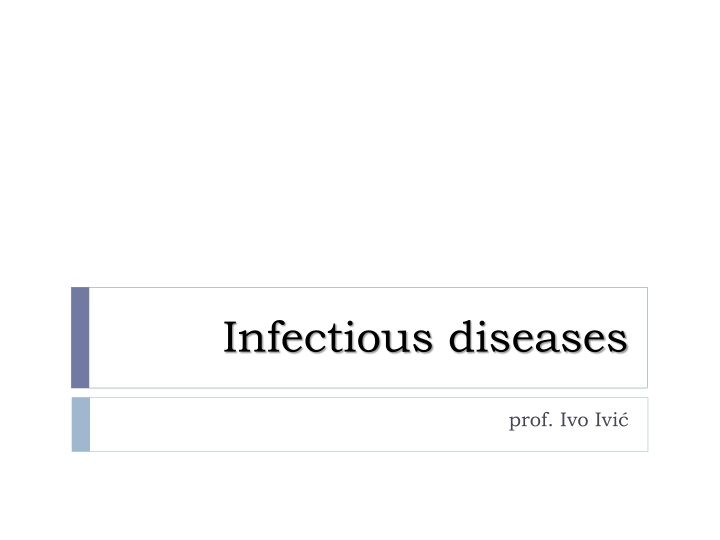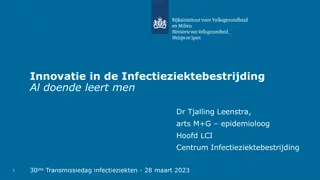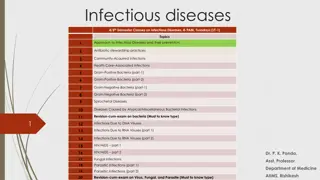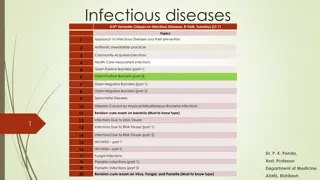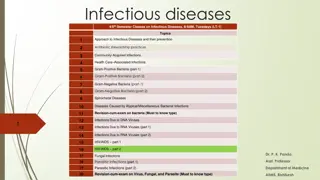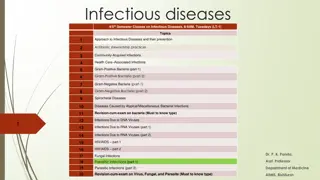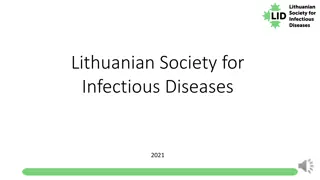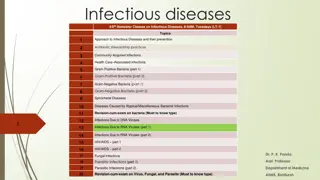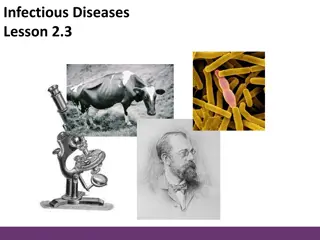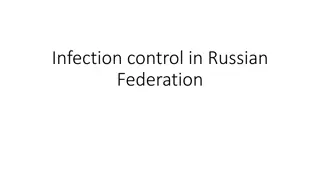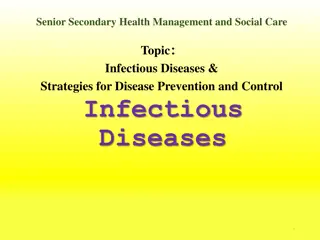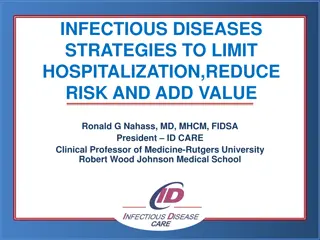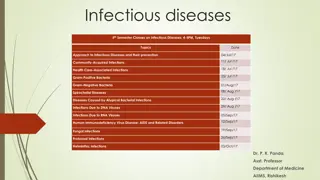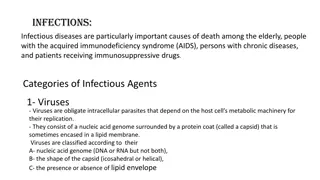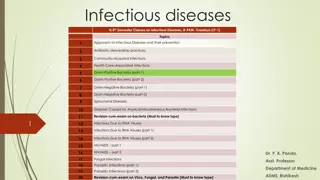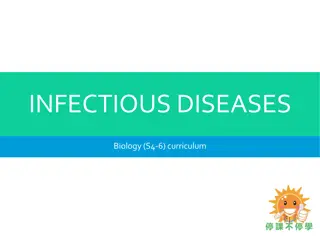Infectious diseases
Infectious diseases are caused by pathogenic microorganisms invading the host's body. This process involves the development of the disease through colonization, invasion, and immune responses. Pathogenic microorganisms exhibit virulence by directly damaging the host or inducing inflammatory responses. Host defenses include both nonspecific innate immunity and specific adopted immunity, which work together to eliminate infections. The stages of infectious diseases involve incubation, symptomatic disease, abatement, convalescence, and potential relapse.
Download Presentation

Please find below an Image/Link to download the presentation.
The content on the website is provided AS IS for your information and personal use only. It may not be sold, licensed, or shared on other websites without obtaining consent from the author.If you encounter any issues during the download, it is possible that the publisher has removed the file from their server.
You are allowed to download the files provided on this website for personal or commercial use, subject to the condition that they are used lawfully. All files are the property of their respective owners.
The content on the website is provided AS IS for your information and personal use only. It may not be sold, licensed, or shared on other websites without obtaining consent from the author.
E N D
Presentation Transcript
Infectious diseases prof. Ivo Ivi
Development of the infectious disease Pathogenic and opportunistic microorganisms Physiological flora Colonization of skin/mucous membranes Invasion Protection from infection Immune response without inflammation Inflammatory response Infectious disease Asymptomatic infection Symptomatic infection Imunost Lifelong Of limited duration
Pathogenicity (virulence) of the microorganism Capacity to invade and damage the host Directly: by Exotoxins (eg. Cl.difficle toxin, tetanus toxin) by Enzymes (eg. Staphylococcal coagulase) by apoptosis/necrosis-lysis of cells (eg. viruses) Indirectly: inducing of the inflammatory response byAntigens and Superantigens Septic / toxic shock Cytokine storm
Non-specific host defenses The innate immunity, independent of the current infection: Integrity of the skin and mucous membranes Preserved physiological flora Phagocytes: neutrophils and macrophages NK cells Non-specific immunoglobulins (eg. opsonins), Interferons
Specific host defenses Occurs during infection = Adopted immunity Finally eliminates current infection Protects against further infections Specific antibodies (specific B lymphocytes) Facilitate phagocytosis of specific microorganism Neutralize specific toxins Specific T cells cytotoxic (Tc): better cytotoxicity than NK cell helper (Th): faster activation of Tc and B lymphocytes
Stages of infectious diseases Incubation Time from infection to onset of symptoms Symptomatic disease Beginning: general symptoms of infection Developed disease: specific symptoms and signs Abatement of disease (defervescence) Convalescence Recrudescence and Relapse
2 Developed disease: general and specific symptoms 3 1 symptoms Abatement (defeverscence) Beginning: general symptoms 4 Convalescence Relapse Recrudescence Incubation Infection time 0 X Stages of infectious disease
Incubation time Multiplication and spread of microorganism. Establishment of the inflammatory response. Short: up to 7 days eg. Flu: usually 2-3 (range 1-7 days) Medium: 1-2 weeks eg. chickenpox: usually 14 days (range 7-23) Long: more than 2 weeks eg.hepatitis B: 1.5 to 6 months Standardized incubation Measels: 11 1 days
General symptoms of infectious diseases often the only symptoms at the beginning (first hours - days) difficult to set a specific diagnosis Fever Fatigue and malaise Loss of appetite Headake Myalgias, arthralgias Flu like disease General pain syndrome
Specific symptoms and signs Indicate the localization of infection or specific inf. disease Abdominal pain, vomiting Watery diarrhea Gastroenteritis Generalized vesicular rash Chickenpox (Varicella) Icterus Enlarged and painful liver Hepatitis
Splenomegaly and infectious diseases The spleen is part of the RES Participates in defense from infection Splenomegaly = generalized infection: Bacteremic typhoid fever, brucellosis Viremic infectious mononucleois Parasitemic visceral leishmaniasis
Outcomes of infectious disease 1. Recovery A. With eradication of pathogen B. Without eradication of pathogen: carrier state (eg. S.typhi), or state of latency (HSV, EBV, HPV) - possible oncogenesis No inflammation 2. Chronic disease (inflammation) A. Progressive - ultimately permanent impairment occur HBV, HCV: liver cirrhosis with / without cancer of the Persistent - a permanent low grade inflammation without visible damage oncogenic transformation is possible B. 3. Death
Epidemiological data Circumstances and risks associated with acquisition infectious diseases Host disease that favor infection: multiple myeloma: S. pneumoniae and H. influenzae sepsis dental surgery : S.viridans endocarditis Similarly ill persons from surroundings Contact with animals: zoonoses Occupational exposure: the veterinary - zoonoses Sexual activity: gonorrhea, HIV, HBV Travel: tropics (malaria, parasitic diarrhea) Consuming of undercooded food: diarrhea Vaccination and history of other infectious diseases, .. etc.
Laboratory evaluation The attempt to distinguish viral from bacterial infection Why? - Fear of delayed antibiotic treatment ESR(erythrocyte sedimentation rate): Accelerated in bacterial infection but also in Adenovirus infection At least 2-3 days are required to increase Accelerated also in non-infectious diseases Useful for monitoring therapeutic response
Laboratory evaluation CRP (C-reactive protein) Increased in bacterial infection The first increase after 8-12 hours diseases Also increased in non-infectious diseases with / without fever Useful for monitoring therapeutic response
White blood cell (WBC) count and differential cell count (DC) Increased WBC + Neutrophilia = bacterial infection but seen also withAdenovirus infection LowWBC = viral infection but seen also in typhoid fever DC: left shift (apperance of non-segmented neutrophils) More common with bacterial infection Ratio n-seg/seg 0,2 = more likely bacterial inf. even with normalWBC count IfWBC count is low = consider serious bacterial infection?
WBC and DC DC: Lymphocytosis mostly viral infection also seen in pertussis (whooping cough) DC: Atypical lymphocytes (activatedT cells) typical for infectious mononucleosis (EBV) but also other viral infections, usually less than 5% ofWBC DC: Eosinophilia High (> 30%) = tissue parasitic infections trichinosis, pulmonary ascariasis, etc.
Plateletes Thrombocytopenia Bacterial sepis (DIC) Also severe viral infections infectious mononucleois, flu hemorrhagic fevers (dengue, HFRS) Thromobocytosis Usualy in convalescence risk of deep vein thrombosis
Cerebrospinal fluid (CSF) Viral CNS infection Bacterial CNS infection Appearance Clear Cloudy Pleocytosis (WBC) Lymphocytosis Neutrophlia Proteins Normal Increased Glucose Normal Low Lactate Normal Increased Gram stained sediment No bacteria Visible bacteria
Urin analysis Urinary tract infection (UTI) Proteins: increased Sediment: Leukocyturia - obligatory Bacteriuria often present Other infections (non-UTI) Abnormal finding possible mild Febrile albuminuria mild Febrile leukocyturia
Imaging methods Chest X-ray Insight into respiratory infection Ultrasound Solid organs: enlargement, abscesses Heart valves: vegetation in endocarditis CT Solid organs of the abdomen, lungs, brain, soft tissues MR Same as with CT + early insight into osteomyelitis Radionuclide imaging (scintigraphy) For osteomyelitis
Detection of infectious agents: direct Culture of bacteria and fungi blood, urine, CSF, swabs, biopsy specimens, . should be obtained before antimicrobial therapy Culture for viruses and parasites are not routine Quick immunochromatic tests Influenza: from nose swab Group A streptococci from throat swabs Rotavirus in stool PCR for pathogen s DNA or RNA In various specimens containing pathogen
Detection of infectious agents: indirect Serological tests detection of specific antibodies (Ab) first few days of illness can be negative Agglutination,et al. (do not separate IgM form IgG) Increasingly rarely used Paired samples are required Proving the current infection : 4-fold titer increase in two samples, or conversion from negative to positive titer
ELISA, IFT, et al.(separately deteminate IgM and IgG) - the most commonly ured tests IgM IgG Type of infection Obtaining of second specimen? No* No No No Yes** + + neg. neg . neg + + neg. Early acute Developed acute Previous No infection (usualy), or Very early acute infection * false positive IgM possible , for example: - presence of RF in sera ** if the same infection remains suspected
Vaccination and prevention of infectious diseases
Immunisation Passive: immunization with pre-formed antibodies Transplacental transfer of maternal IgG Administration of human immunoglobulins human tetanus IgG (HTIG) Administration of animal immunoglobulins(serums) botulinum immunoglobulin, anti-viper serum Administration of monoclonal antibodies RSV
Immunisation Active: immunization with antigens = the vaccines Live attenuated microbs: measles, mumps, rubella (MMR), varicella 1) Killed (inactivated) microbs: Intramuscular polio, influenza, hepatitis A 2) Reasorted viral vaccines ( arteficial virus ) genetic rearrangement of different viruses RotaTeq vaccine: 4 serotypes of rotavirus 3)
Immunisation Recombinantly derived viral antigens: gene of the vaccine antigen is incorporated into the DNA of yeasts or bacteria HBV, HPV 4) Toxoids Inactivated toxicity, preserved immunogenicity of toxin Diphteria, tetanus 5) Purified bacterial antigens (acellular vaccine) SolitaryAg: S.pneumoniae (polysaccharide vaccine) MultipleAg: B.pertussis (PT, FHA, Pertactin Fimbriae) 6) a) b)
Immunisation About polysaccharide vaccines 1. Polysaccharide: Good immunogenicity for adults Weak immunogenicity for children aged 2 years poor activataors of CD4 lymphocyte (Th) in chldren 2. Conjugated poysaccharide: poysaccharide + protein (eg. recombinant diphteria toxoid) good immunogenicity for childrena (and adults)
General contraindictions for vaccination Previous allergy to same vacccine Anaphylactic egg allergy, such as urticaria eg: Influenza vaccine Measels and mumps??- not any more Instead on egg, now are produced on chicken fibroblasts culture Serious immunodeficiency / immunosupression and pregnacny Live vaccines are contraindicated
Serious immunodeficy (contraindications for live vaccines) Congenital immunodeficiency HIV infection if in advanced stage otherwise, allowed and recommended Lymphoma, leukemia Malignancies on therapy Corticosteroid therapy: prolonged or high dose > 2 mg/kg/day for more than 2 weeks About varicella vaccine: Cellular immudeficiecy- NO, do no vaccinate Hypo/disgamalobulinemija-YES, do vaccinate
Mandatory vaccines in RH 2016-2018- calendar Age MONTHS YEARS GRADE OF ELEMENT. SCHOOL YEARS 0 2 4 6 1 5 I. VI. VIII. 19 24 60 VACCINE BCG Hib DTPer Polio DT MPR Hep.B x3 T LEGEND: BCG: tuberculosis. Hib: Hemophilus infuenzae type b. DTPer; Diphteria, Tetanus, Pertussis acelullar vacc. Polio: Inactivated PolioVirus. DT: Diphteria andTetanus. MPR: Morbilli, Parotitis, Rubeola. HepB: hepatitis B virus. T: Tetanus
Reduceing the number of vaccine doses (punctures) 1 2 3 Vaccine 3 in 1 (D T Pa) 4 5 Vaccine 5 in1 (DTPa + IPV+ Hib) 6 Vaccine 6 in 1 (DTPa + IPV+ Hib + HBV)
Optional, but recommended vaccines Influenza all children and adults, especially those at high risk S.pneumoniae Children conjugated vaccine all, especially high risk children Adults - conjugated and non-conjugated vaccines Those at risk, all aged 65 years Rotavirus All children
HPV All girls and boys before puberty Varicella (VZV) Persons at risk reproductive age women with no history of varicella Herpes zoster (VZV) Persons aged >50 years
TBE- tick borne encepahalitis Professional exposure pre exposure vaccination Forestworkers, hunters, nature lovers Following tick bite in an endemic area- post exposure vacc. A and C meningococcus (polisaccharide non conjugated) Travel to Sub-Saharan meningococcal belt The occurrence of disease in a collective (military barracks, sudent s home, etc.) B meningococcus (recombinant protein vaccine) All children (50% of invasive meningoccal infections in children)
Misunderstandings or What is not a contraindication for vaccination? Current mild acute illness with or without fever Recovery from recent illness Current antibiotic therapy Recent contact with infective diseases Breast-feeding Mild or moderate local reactions to a previous vaccine Mild or moderate fever after previous vaccination Allergy to antibiotics (penicillin or others.) Current immunotherapy with extracted allergens
Approach to infectious diseases prophylaxis Modes Chemoprophylaxis: using antimicrobial drugs Immunoprophylaxis: Active: vaccination Pasive: immunoglobulins, monoclonalAb individually or combined Timing Pre-expoure Post-expoure including perinatal period
Pre-exposure prophylaxis (examples) Vaccination Mandatory vacccines Travel to risk areas: yellow fever, hepatitis A Immunoglobulins Epidemic of RSV infections (bronchiolitis): monoclonal anti-RSV Ab for children with cystic fibrosis Chemoprophylaxis Travel to malaria areas: Chloroquin Combined pre-exposure prophylaxis Non-vaccinated high risk persons during flu epidemics: Oseltamivir (antiviral drug) + vaccination
Postexposure prophylaxis (examples) Meningococcal diseae To close contact persons : Rifampin /2 days Tetanus (lockjaw): contaminated wound Unvaccinated, incomplet or unknown vaccine status: HTIG (human tetanus IgG) + vaccination (AnaTe) Fully vaccinated 5 years ago : only boosterAnaTe Fully vaccinated < 5 years ago: nothing
